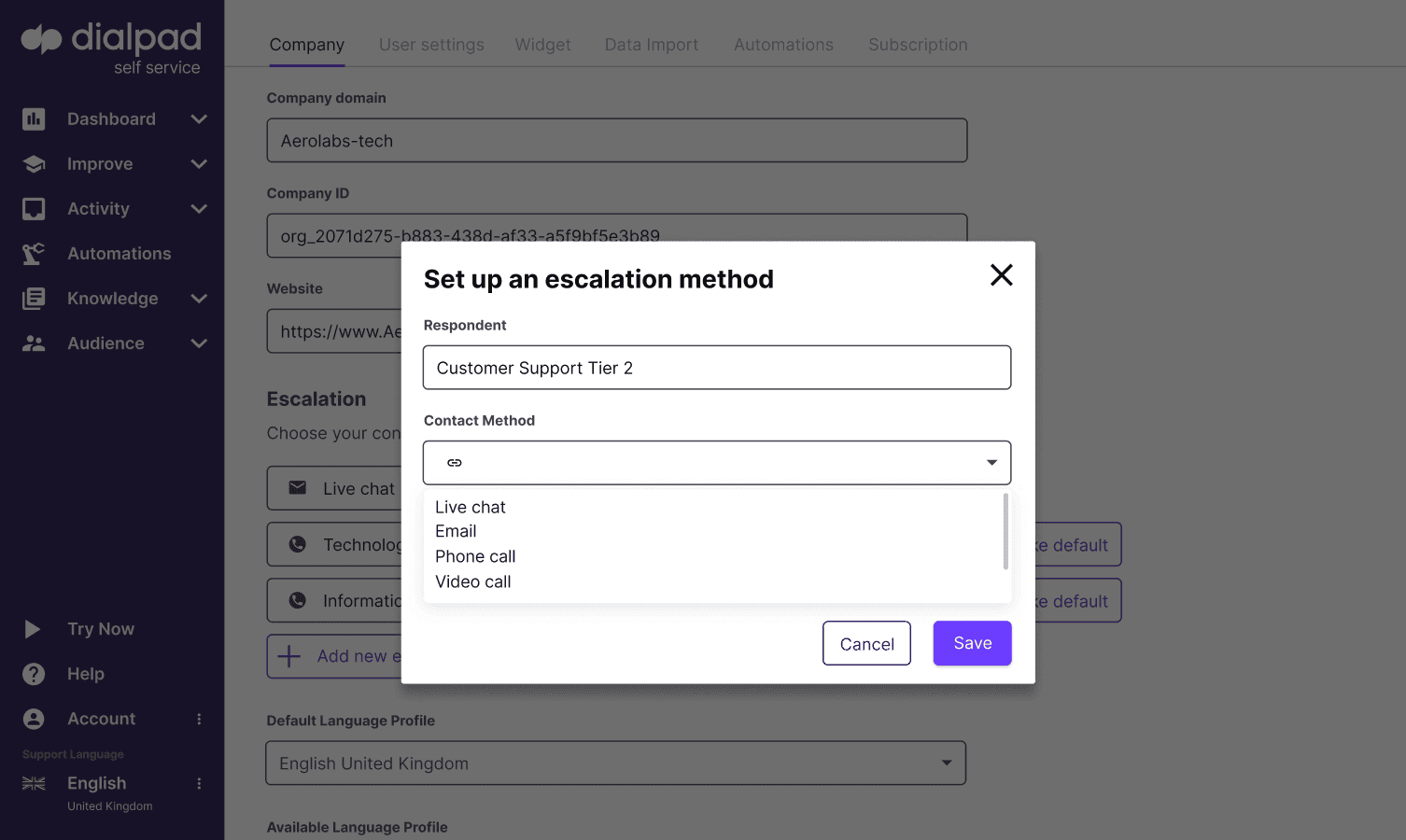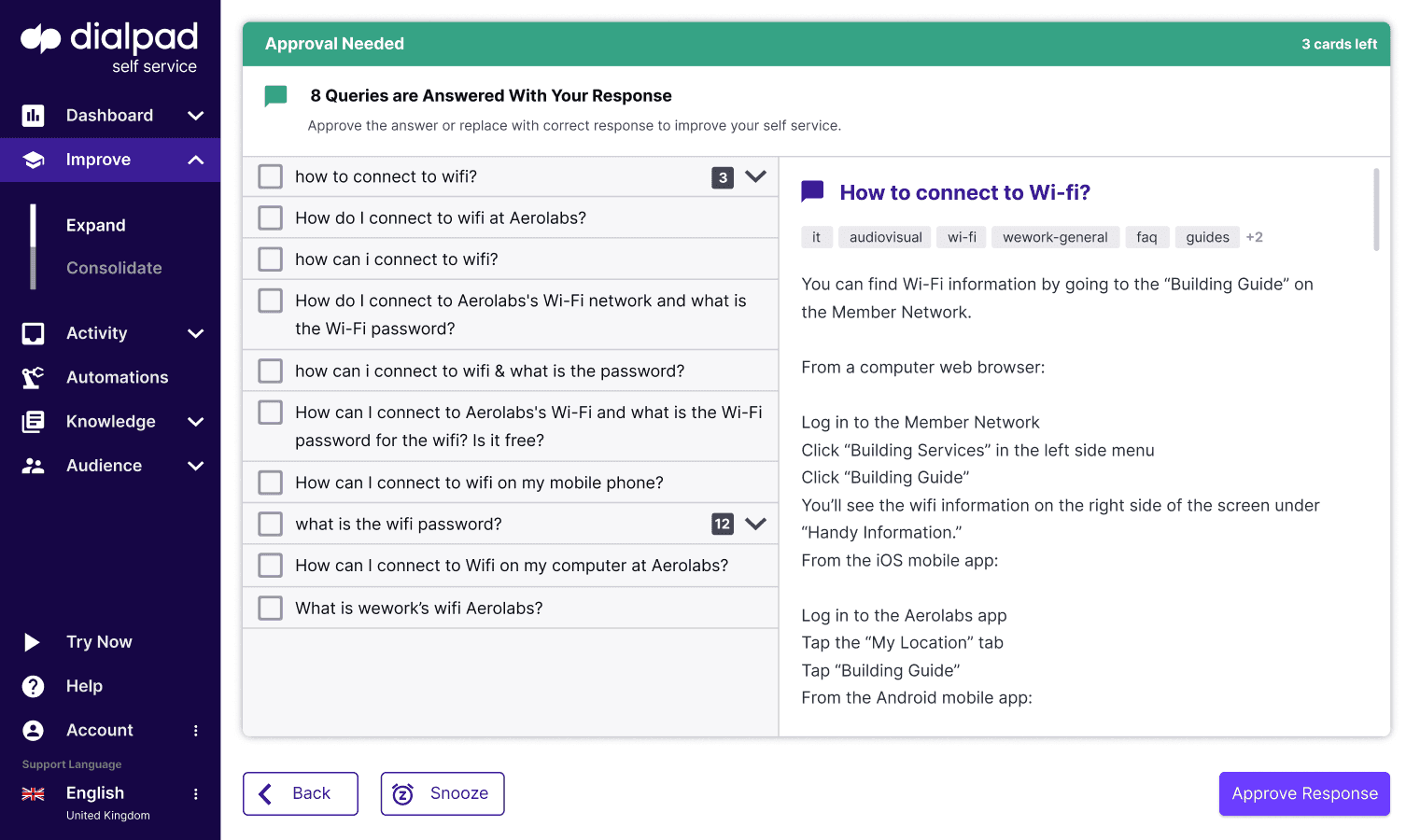Recruitment chatbots: How to get more great talent in the door

VP of Talent Acquisition

Tags
Share
Regardless of the job market, employers are always looking for new ways to improve the attraction and selection of talent. One increasingly popular solution is by using a recruitment chatbot.
Chatbot technology can be used to automate easy questions and reduce the burden on busy recruitment teams—tasks like responding to questions about a position, scheduling interviews, and follow-ups after the interview.
While investing in a recruitment chatbot can be a great way to get more qualified candidates through the door, traditional chatbot technologies are typically very manual, and lack escalation capabilities that help candidates and hiring managers get what they need.
By comparison, more and more recruiters today are employing conversational AI—think of it as the next evolution of the traditional chatbot. Unlike conventional chatbot experiences, employing a self-service tool powered by conversational AI can deliver complex and nuanced answers and even escalate interactions to live recruitment staff.
As a recruiting team ourselves, we’re very much testing and exploring conversational AI (especially as we work at Dialpad!), and in this post, we’ll look closer at how traditional chatbots and conversational AI compare.
What is a recruitment chatbot?
Recruitment chatbots are artificial intelligence-powered tools that use natural language processing (NLP) and machine learning to simulate conversations with candidates applying for roles at your company, on behalf of your recruiting team.
Recruitment chatbots are designed to engage with candidates—some of the more sophisticated ones can even collect contact information, skills and experiences, and ask other pre-screening questions to match candidates with open positions.
Job seekers can message your chatbot and ask questions, just as they would in a human interaction. The chatbot then responds accordingly, providing information or carrying out actions like putting through a job application.
For example, a job seeker might ask a chatbot on your website clarifying questions about the application process for a particular role. The chatbot would then provide information on how to apply, what the next steps are, and so on.
Setting up a recruitment chatbot is generally pretty simple and doesn’t require any coding knowledge. There are a number of off-the-shelf solutions and contact center software available that lets you do this, like Dialpad Ai Contact Center:

Once you’ve set up your chatbot, you can promote it to potential candidates through your company website and other digital channels like social media and SMS text messaging.
📚 Further reading:
Learn more about Dialpad’s conversational AI functionality.
The benefits of investing in chatbots or conversational AI for recruitment
It automates tasks to save your recruiters time
One of the biggest benefits of using chatbots or AI self-service tools as part of your recruitment technology stack is that either method can automate repetitive tasks in the recruiting process, such as answering candidate questions, scheduling interviews, and sending reminders.
This can be a huge time-saver for recruiting teams.
While chatbots require a bit more hands-on management to map questions to answers, self-service tools powered by conversational AI are able to understand user intent and immediately answer questions based upon connected knowledge. It’s even able to suggest custom workflows or automations that simplify the application process.
It improves your candidate experience (and employer branding!)
Recruiters are busy, and they can’t always respond quickly to candidates. By providing quick and efficient responses to easy questions, chatbots—and to a greater degree, conversational AI (because it can handle a wider variety of more complicated questions)—can help with candidate engagement and create a positive impression of your company for potential employees.
If you invest in a conversational AI like Dialpad’s Ai Virtual Assistant, there is even a way to escalate from a self-service interaction with the AI to speak with someone live if you can’t find an answer to your question.
This will lead to good reviews of your hiring process on popular third-party career sites like Glassdoor and LinkedIn—which widens your talent pool and can lead to more applications for open positions in the future.
It improves your response rates
Chatbots can also improve response rates. Today, there’s a wide variety of different touchpoints that candidates can use to apply for a job. Not everyone prefers or responds to phone calls, especially if you’re sourcing candidates in the Gen Z demographic. SMS text messaging and social media, on the other hand, tend to get more responses (and often, more quickly too).
It speeds up your time-to-hire
Another benefit is that chatbots and self-service tools like Dialpad’s Ai Virtual Assistant can be used on a variety of platforms, including websites, social media, and even messaging apps (like WhatsApp). This gives job seekers more opportunities to interact with the chatbot and learn about open positions.
📚 Further reading:
Learn more about recruiting tips in this guide by Alice, our Talent Acquisition Lead!
Traditional recruitment chatbots vs. conversational AI
Now, let’s take a closer look at how conventional chatbots differ from self-service tools that employ conversational AI.
Recruitment chatbots are tools designed to answer questions mapped to preset answers from candidates applying for roles at your company, on behalf of your recruiting team.
Some of the more sophisticated chatbots can deliver form-fills that collect contact information, skills and experiences, or other pre-screening questions needed to match candidates with open positions.
For example, a job seeker might ask a chatbot on your website clarifying questions about the application process for a particular role. The chatbot would then provide information on how to apply, what the next steps are, and so on.
Because chatbots rely on pre-populated responses, setting up a recruitment chatbot is a fairly manual process that requires the mapping of potential questions to answers and processes. This is one of the main differentiating factors between a traditional recruitment chatbot and conversational AI.
Dialpad’s Ai Virtual Assistant is powered by conversational AI, that uses natural language processing (NLP) and machine learning to simulate conversations with candidates applying for roles at your company, on behalf of your recruiting team. (Think of ChatGPT as an example.)
The Ai Virtual Assistant is designed to greatly improve upon the traditional chatbot experience. Instead of manually mapping questions to responses, Dialpad uses advanced machine learning, natural language processing, and AI parenting to automate these complex conversational flows.
This means when recruitment teams connect knowledge sources, web sites, job postings, and more to Dialpad’s Ai Virtual Assistant, the tool can immediately respond to any applicant question with the most relevant response in real-time.
All this with no IT intervention, data scientists, or AI specialists needed on your team!
(Dialpad’s Ai Virtual Assistant even has the ability to recognize and differentiate between users. For example, the AI can understand if it’s communicating with a hiring manager or an applicant and adjust the responses accordingly.)
Lastly, something that we find very helpful with our brand of conversational AI is its ability to understand what questions aren’t covered within connected knowledge sources, so the recruitment team can easily add that information quickly and easily.
3 challenges of recruitment chatbot tools to keep in mind
1. They can’t fully replace the human touch
Even with an investment in a self-service tool powered by conversational AI, nothing can replicate the intuition and personal touch of a human recruiter.
That’s actually an important consideration in the design of Dialpad’s cloud contact center platform, which is why we’ve built in the ability to transition an automated interaction to a live conversation with a recruiter via chat, phone call, or video meeting:

This allows you to keep the human element in your client experience and improve digital customer engagement—and more importantly, link everything seamlessly to the automated piece of the experience.
This way, your candidates can easily escalate the interaction to a human (under the right circumstances) if needed.
2. The quality of the experience depends on the quality of your inputs
Another challenge is that the self service experience is only as good as the data given. If you don’t input high-quality data, you won’t get high-quality metrics and results. This is why it’s important to have a well-designed recruitment strategy from the outset. You need to think about what data you want to collect and how you will use it to improve your recruiting process.
But having to constantly input new data and workflows can be pretty high-effort (and potentially costly). This is a big reason why no-code conversational AI is quickly overtaking chatbots—it can learn on its own without that manual input.
Dialpad’s conversational AI, for instance, can identify key patterns and insights in every chatbot interaction and then use this data to flag opportunities for improving the automated logic:

The result? Over time, the recruitment chatbot itself can get better and better at its "job,” with minimal human intervention needed.
3. Potentially high costs
Chatbots can be expensive to implement and maintain—especially if you’re purchasing this software separately from your contact center or communications platforms.
If you can, look for robust, fully integrated tools. Not only will this save you from having to pay for multiple disparate hiring tools, it’s also easier for end users (since they don’t have to juggle a large number of apps) and your IT team (since they don’t have to manage and admin so many tools).
Innovative uses cases for chatbots and conversational AI in recruitment
When it comes to recruiting activities, chatbots and self-service tools can be used in a number of innovative ways in order to help talent acquisition teams save time and attract more candidates. Here are three examples:
Automating the initial screening process
One way that self-service tools can be used in talent acquisition and recruitment is by automating the initial screening process. This means that rather than having a recruiter or HR Manager manually review each application (which can be incredibly time-consuming), a recruitment bot can be used to do this instead. This helps recruitment teams streamline their workflows considerably, and save on both time and resources.
Supporting a more high-touch candidate experience
Another innovative use case for self-service in recruitment is to improve the candidate experience. One common challenge when hiring is that candidates often feel like just a number—once they submit an application, they don’t really hear back from hiring companies unless they’re moving forward in the interview process.
No follow-ups, no acknowledgments of receipt, no way of asking questions about the job posting. This can create a poor employer brand, which can negatively impact your recruitment efforts. A recruiting software can help reduce the burden on your busy team, while still providing answers and giving the impression that your business is responsive to potential employees—whether or not they end up getting the job.
Interview scheduling
Finally, self-service tools can also be used to schedule follow-up interviews with candidates. This is a great way to keep candidates engaged throughout the recruitment process in real time and ensure that you don't forget to follow up with them.
Improve your recruitment experience with Dialpad
If you have a busy recruitment team that’s finding it challenging to handle all the applications and candidates coming in, Dialpad can help. Used strategically, we can help your business get more qualified candidates, all the way from recruiting through to the onboarding process—while still maintaining that human touch throughout.
Looking for a recruitment chatbot tool?
Book a personal walkthrough of Dialpad, or take a self-guided interactive tour of the app on your own first!









